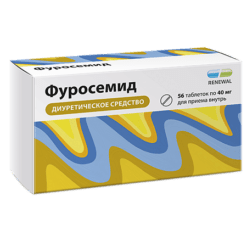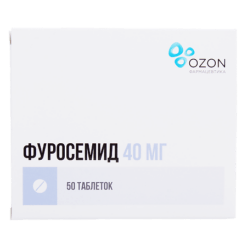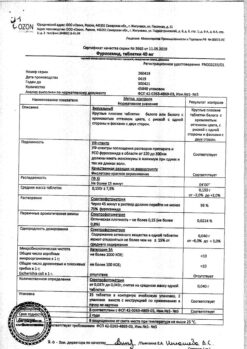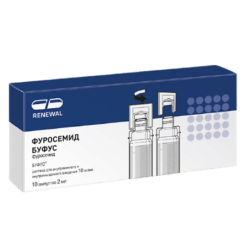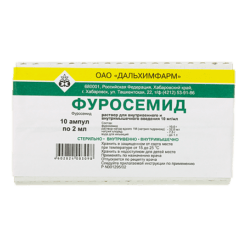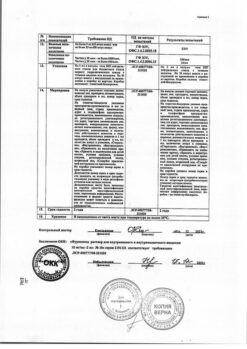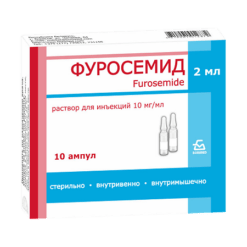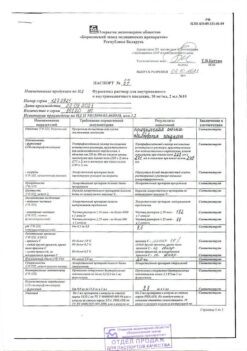No products in the cart.
Furosemide, tablets 40 mg 50 pcs
€1.00
Out of stock
(E-mail when Stock is available)
Description
A “loop” diuretic; causes rapid onset, strong and short-term diuresis. It has natriuretic and chloruretic effects, increases excretion of K+, Ca2+, Mg2+. Penetrating into the renal tubule lumen in the thick segment of the ascending knee of the Genle loop, it blocks reabsorption of Na+ and Cl-. Due to an increase in Na+ excretion, there is a secondary (mediated by osmotically bound water) enhanced water excretion and increased K+ secretion in the distal part of the renal tubule. At the same time the Ca2+ and Mg2+ excretion increases.
It has secondary effects due to release of intrarenal mediators and redistribution of intrarenal blood flow. There is no attenuation of the effect during the course of treatment.
In case of CH, it quickly leads to a decrease of the preload on the heart by means of expansion of the large veins. It has a hypotensive effect due to increase in NaCl excretion and decrease in the response of vascular smooth muscle to vasoconstrictor effects and due to decrease of the circulatory blood pressure.
The action of furosemide after intravenous administration occurs within 5-10 min; after oral administration it takes 30-60 min, maximum action 1-2 h, the duration of effect – 2-3 h (with reduced renal function – up to 8 h).
At the time of action, Na+ excretion increases significantly, but after its cessation, the excretion rate decreases below the initial one (the syndrome of “ricochet” or “withdrawal”). The phenomenon is due to a sharp activation of the RAAS and other antinatriuretic neurohumoral regulatory links in response to massive diuresis; it stimulates the arginine-vasopressive and sympathetic nervous systems. It decreases the concentration of atrial natriuretic factor in plasma and causes vasoconstriction. Due to the phenomenon of “ricochet” when administered once a day may not have a significant effect on daily Na+ excretion and BP.
Pharmacokinetics:
TCmax by IV infusion is 30 min.
The relative volume of distribution is 0.2 L/kg. Binding with plasma proteins – 98%. It penetrates through the placental barrier and is excreted with breast milk. Metabolized in the liver with the formation of 4-chloro-5-sulfamoylanthranilic acid. It is secreted into the lumen of renal tubules through the anion transport system existing in the proximal nephron. Clearance is 1.5-3 ml/min/kg. T1/2 is 0.5-1 hours.
Extracted mainly (88%) by kidneys unchanged and as metabolites; in the feces – 12%.
Indications
Indications
Active ingredient
Active ingredient
How to take, the dosage
How to take, the dosage
Interaction
Interaction
Increases the concentration and risk of nephro- and ototoxic effects of cephalosporins, aminoglycosides, chloramphenicol, etacrynic acid, cisplatin, amphotericin B (due to competitive renal excretion).
It increases efficacy of diazoxide and theophylline and decreases efficacy of hypoglycemic drugs, allopurinol.
It reduces renal clearance of Li+ drugs and increases possibility of intoxication.
It enhances the hypotensive effect of hypotensive drugs, neuromuscular blockade caused by depolarizing myorelaxants and weakens the effect of nondepolarizing myorelaxants.
Presor amines and furosemide mutually reduce efficacy.
Drugs that block tubular secretion increase the serum concentration of furosemide.
The concomitant use of GCS, amphotericin B increases the risk of hypokalemia, with cardiac glycosides increases the risk of digitalis intoxication due to hypokalemia (for high and low-polar cardiac glycosides) and prolongation of T1/2 (for low-polar ones).
The NSAIDs, sucralfate decrease diuretic effect due to inhibition of Pg synthesis, changes in plasma renin concentration and aldosterone release.
The administration of salicylates in high doses with furosemide therapy increases the risk of their toxicity (due to competitive renal excretion).
Cyclosporine – risk of gouty arthritis due to hyperuricemia caused by furosemide and impaired renal excretion of urate by cyclosporine.
Patients at high risk of nephropathy on radiopaque administration who received furosemide had a higher incidence of renal function impairment compared to patients at high risk of nephropathy on radiopaque administration who received only IV hydration before radiopaque administration.
Injectable furosemide is slightly alkaline, so it should not be mixed with an LP with a pH less than 5.5.
Special Instructions
Special Instructions
During the course of treatment it is necessary to monitor periodically BP, plasma electrolyte concentration (including Na+, Ca2+, K+, Mg2+), COC, residual nitrogen, creatinine, uric acid, liver function and if necessary make the appropriate treatment correction (with greater frequency in patients with frequent vomiting and with parenterally administered fluids).
Patients with hypersensitivity to sulfonamides and sulfonylurea derivatives may have cross-sensitivity to furosemide.
Patients receiving high doses of furosemide should not limit their intake of table salt to avoid the development of hyponatremia and metabolic alkalosis.
In order to prevent hypokalemia, concomitant administration of K+ preparations and potassium-saving diuretics (primarily spironolactone) is recommended, as well as adherence to a diet rich in K+.
In patients with renal insufficiency there is an increased risk of the development of water-electrolyte balance disorders.
The dosage regimen of patients with ascites due to cirrhosis should be chosen under hospital conditions (disorders of water-electrolyte balance may lead to hepatic coma). Regular monitoring of electrolytes in plasma is indicated for this category of patients.
If azotemia and oliguria appear or worsen in patients with severe progressive renal disease, it is recommended to stop treatment.
It is excreted with milk in women during lactation; therefore, discontinuation of lactation is advisable.
In patients with diabetes or with reduced glucose tolerance, periodic monitoring of blood and urine glucose concentrations is required.
In unconscious patients with prostatic hypertrophy, ureteral narrowing, or hydronephrosis, monitoring of urine output is necessary due to the possibility of acute urinary retention.
At the time of treatment, potentially hazardous activities requiring increased attention and quick psychomotor reactions should be avoided.
Contraindications
Contraindications
Side effects
Side effects
System adverse reactions: decreased BP, orthostatic hypotension, collapse, tachycardia, arrhythmias, decreased blood circulation.
Nervous system disorders: dizziness, headache, paresthesias, apathy, adynamy, weakness, drowsiness, somnolence, confusion.
Sensory organs: visual and hearing disorders.
Digestive system disorders: decreased appetite, dry mouth, thirst, nausea, vomiting, constipation or diarrhea, cholestatic jaundice, pancreatitis (exacerbation).
Urogenital system disorders: oliguria, acute urinary retention (in patients with prostatic hypertrophy), interstitial nephritis, hematuria, decreased potency.
Allergic reactions: purpura, urticaria, exfoliative dermatitis, erythema multiforme, vasculitis, necrotizing angiitis, skin itching, chills, fever, photosensitization, anaphylactic shock.
Hematopoietic organs: leukopenia, thrombocytopenia, agranulocytosis, aplastic anemia.
Water-electrolyte metabolism: hypovolemia, dehydration (risk of thrombosis and thromboembolism), hypokalemia, hyponatremia, hypochloremia, hypocalcemia, hypomagnesemia, metabolic alkalosis.
Others: muscle weakness, cramps of the calf muscles (tetany).
Laboratory parameters: hyperglycemia, hypercholesterolemia, hyperuricemia, glucosuria, hypercalciuria.
In intravenous administration (additionally) – thrombophlebitis, renal calcinosis in premature infants.
Overdose
Overdose
Symptoms: marked BP decrease, collapse, shock, hypovolemia, dehydration, hemoconcentration, arrhythmias (including AV block, ventricular fibrillation).
Treatment: correction of water-salt balance and COC, augmentation of the blood circulation, symptomatic treatment. There is no specific antidote.
Additional information
| Shelf life | 3 years |
|---|---|
| Conditions of storage | In a dry, light-protected place at a temperature not exceeding 30 °C |
| Manufacturer | Borisov Medical Preparations Plant, Belarus |
| Medication form | pills |
| Brand | Borisov Medical Preparations Plant |
Other forms…
Related products
Buy Furosemide, tablets 40 mg 50 pcs with delivery to USA, UK, Europe and over 120 other countries.


